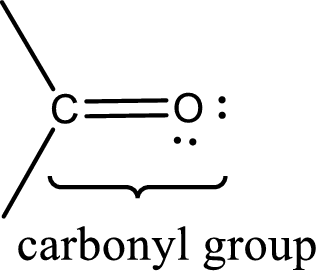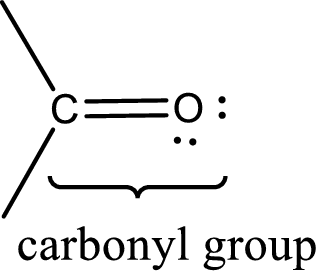
(a)
Interpretation:
The compound that has higher solubility in water among the given pair has to be identified.
Concept Introduction:
Carbonyl groups are the one which contain a double bond between carbon and oxygen atom.

Aldehydes contain a carbonyl group that contains a hydrogen atom and a carbon atom bonded to it. Aldehyde that has one and two carbon atoms are gas at room temperature. The physical state of aldehyde that contains three carbon atoms to eleven carbon atoms that are not branched is liquid at room temperature. Aldehydes that contain more than eleven carbon atoms are solid at room temperature.
Ketones contain a carbonyl group that contains two carbon atoms bonded to it. For a compound to be ketone, a minimum of three carbon atom is required. Ketones that contain three carbon atoms to eight carbon atoms which have the carbonyl group at the second carbon atom are liquid at room temperature.
Solubility of aldehydes and ketones depend upon the length of the carbon chain. Those contain less than six carbon atoms are soluble in both water and organic solvents. Aldehydes and ketones that contain six or more carbon atoms are not soluble in water but soluble in organic solvents only. Solubility of smaller ketones and aldehydes are result of the hydrogen bond formation between the lone pairs of oxygen atom and the hydrogen atom in the water molecule.
(b)
Interpretation:
The compound that has higher solubility in water among the given pair has to be identified.
Concept Introduction:
Carbonyl groups are the one which contain a double bond between carbon and oxygen atom. Aldehydes and ketones possess this carbonyl functional group in it. The structural representation of a carbonyl group can be given as shown below,

Aldehydes contain a carbonyl group that contains a hydrogen atom and a carbon atom bonded to it. Aldehyde that has one and two carbon atoms are gas at room temperature. The physical state of aldehyde that contains three carbon atoms to eleven carbon atoms that are not branched is liquid at room temperature. Aldehydes that contain more than eleven carbon atoms are solid at room temperature.
Ketones contain a carbonyl group that contains two carbon atoms bonded to it. For a compound to be ketone, a minimum of three carbon atom is required. Ketones that contain three carbon atoms to eight carbon atoms which have the carbonyl group at the second carbon atom are liquid at room temperature.
Solubility of aldehydes and ketones depend upon the length of the carbon chain. Those contain less than six carbon atoms are soluble in both water and organic solvents. Aldehydes and ketones that contain six or more carbon atoms are not soluble in water but soluble in organic solvents only. Solubility of smaller ketones and aldehydes are result of the hydrogen bond formation between the lone pairs of oxygen atom and the hydrogen atom in the water molecule.
Trending nowThis is a popular solution!

Chapter 15 Solutions
General, Organic, and Biological Chemistry
- How do you distinguish each of the following compound using chemical tests.i. Propanone and ethanalii. Phenyl methyl ketone and ethyl phenyl ketonearrow_forward1. List the reasons why pentanol has a higher boiling point when compared to its corresponding alkane, pentane.arrow_forwardGen. Structure Solubility in Water Chemical Reactivity Aldehyde Ketonearrow_forward
- Explain why methanol and water are completely miscible, while pentanol is only slightly soluble in water?arrow_forwardVanillin can be recrystallized from water because it is slightly soluble in warm water. Which functional group of vanillin is mostly responsible for the slight water solubility? Why is vanillin not completely soluble in water?arrow_forward1. What are the substances present in the label of formaldehyde (formalin)? 2. What is the percentage composition of acetone in the nail polish remover? 3. According to your interview, what is/are the uses of formalin and acetone? A. Uses of Formalin- B. Uses of Acetone - 4. What type of bond is present in the two structures? 5. Why do you think aldehydes and ketones belong to the group of carbonyl containing compounds?arrow_forward
- 5. What is the most dominant intermolecular forces of attraction that exist between: a. water and limonene, the major monoterpene component of lemon essential oil? b. water and constituent ions of sodium chloride? 6. Between the two answers in number 6, which pair exhibits a stronger attraction between the molecules? 7. Describe what happens during salting-out process in terms of the forces of attraction involved as sodium chloride is added into the water-essential oil mixture.arrow_forward1. WRITE THE IUPAC NAME OF THIS ETHER CH3CH2-O-CH2CH2CH2CH2CH3 2. HOW DO PHENOLS DIFFER FROM ALCOHOLS IN TERMS OF STRUCTURE AND PROPERTIES? 3. HOW DO PHENOLS DEIFFER IN PROPERTIES FROM AROMATIC HYDROCARBONS?arrow_forwardGlycerol contains: a. oxygens which are each bonded to two alkyl groups b. oxygens single-bonded to primary and secondary carbons c. Oxygens double-bonded to carbon, with alkyls on both sides d. Oxygens double-bonded to carbon, with alkyls on one side only e. Oxygens double-bonded to carbon, with an alkyl on one side and an --OH on the other sidearrow_forward
- Which of the following compounds in the simplest ketone? A.) methanone B.) ethanone C.) propanone D.) butanone E.) pentanonearrow_forward1. Which of the following structural features is possessed by aldehydes but not ketones? a. At least one hydroxyl group is bonded to the carbonyl carbon atom. b. At least one hydrogen atom is bonded to the carbonyl carbon atom. c. The carbonyl carbon atom is bonded to two other carbon atoms. d. The carbonyl carbon atom is part of a ring structure. 2. What is the IUPAC name of the following compound in the attached photo? a. 3-chloro-4-nitrobenzoic acid b. 2-chloro-4-carboxynitrobenzene c. 2-nitro-5-carboxychlorobenzene d. 2-chloro-1-nitro-4-benzoic acid 3. Which of the following is the correct bond-line structure for CH3C≡C(CH2)2CH(CH3)2? a. Structure I b. Structure II c. Structure III d. Structure IVarrow_forwardAssign the IUPAC name to each of the following ethers. Name the smaller alkyl group as the alkoxy group. a. CH3CH2OCH2CH2CH3 b. c. d.arrow_forward
 Chemistry for Today: General, Organic, and Bioche...ChemistryISBN:9781305960060Author:Spencer L. Seager, Michael R. Slabaugh, Maren S. HansenPublisher:Cengage Learning
Chemistry for Today: General, Organic, and Bioche...ChemistryISBN:9781305960060Author:Spencer L. Seager, Michael R. Slabaugh, Maren S. HansenPublisher:Cengage Learning Organic Chemistry: A Guided InquiryChemistryISBN:9780618974122Author:Andrei StraumanisPublisher:Cengage Learning
Organic Chemistry: A Guided InquiryChemistryISBN:9780618974122Author:Andrei StraumanisPublisher:Cengage Learning General, Organic, and Biological ChemistryChemistryISBN:9781285853918Author:H. Stephen StokerPublisher:Cengage Learning
General, Organic, and Biological ChemistryChemistryISBN:9781285853918Author:H. Stephen StokerPublisher:Cengage Learning Organic And Biological ChemistryChemistryISBN:9781305081079Author:STOKER, H. Stephen (howard Stephen)Publisher:Cengage Learning,
Organic And Biological ChemistryChemistryISBN:9781305081079Author:STOKER, H. Stephen (howard Stephen)Publisher:Cengage Learning, Chemistry: Principles and PracticeChemistryISBN:9780534420123Author:Daniel L. Reger, Scott R. Goode, David W. Ball, Edward MercerPublisher:Cengage Learning
Chemistry: Principles and PracticeChemistryISBN:9780534420123Author:Daniel L. Reger, Scott R. Goode, David W. Ball, Edward MercerPublisher:Cengage Learning




